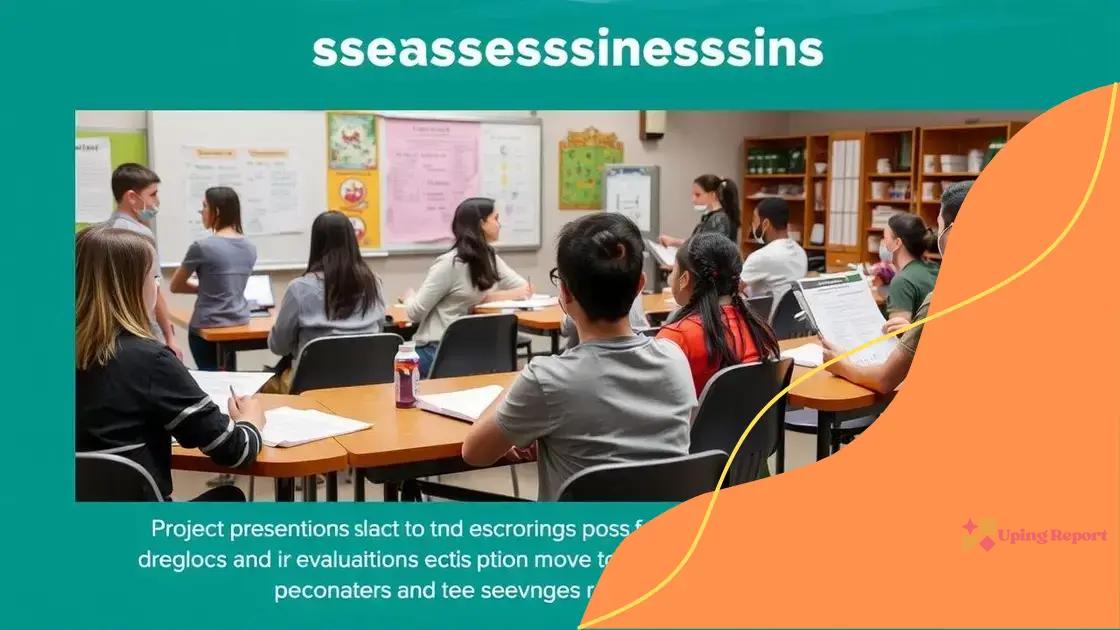Postsecondary education reforms 2025: what’s changing?

Postsecondary education reforms focus on personalized learning, increased use of technology, and lifelong learning to improve student outcomes and better prepare learners for the workforce.
Postsecondary education reforms 2025 are creating waves in how institutions approach learning. Curious about what’s changing? Let’s dive into the significant shifts that promise to shape the future of education.
Understanding the goals of education reforms
Understanding the goals of education reforms is crucial for grasping how these changes will impact students and institutions. These reforms are designed to improve educational quality, accessibility, and relevance in a rapidly changing world. By examining the goals, we can see how they aim to transform the learning experience.
Key Objectives of Education Reforms
At the heart of education reforms are several key objectives that guide the changes being implemented. These include:
- Enhancing student engagement through interactive learning.
- Promoting equity in access to educational resources.
- Incorporating technology for personalized education experiences.
These objectives highlight the importance of catering to all students’ needs and preparing them for future challenges.
Promoting Lifelong Learning
One of the significant goals is to foster a culture of lifelong learning. This approach encourages individuals to pursue knowledge and skills throughout their lives, not just during their formal education years. By focusing on lifelong learning, educational institutions are creating flexible pathways for all learners.
Connecting education to workforce demands is essential. This connection ensures that students acquire relevant skills that align with job market needs. For instance, collaborations between schools and industries can help shape curricula that prepare students for real-world challenges.
Creating Inclusive Learning Environments
Another crucial goal is to create inclusive learning environments. This inclusion means addressing the diverse needs of students from various backgrounds. Diversity in education enriches the learning experience and promotes mutual respect among students.
By implementing inclusive practices, schools not only boost academic performance but also foster social cohesion. As we move forward, the focus on inclusion will continue to grow, ensuring that all students have a seat at the table.
Ultimately, understanding the goals of education reforms helps us see the bigger picture. These changes are not just about policy; they aim to improve the lives of students and equip them for success in an ever-evolving world. Recognizing these goals can engage stakeholders and inspire a collective effort towards achieving a more effective educational landscape.
Key changes in curriculum development
Key changes in curriculum development are shaping how education is delivered across various institutions. This evolution focuses on fostering critical thinking and real-world skills that students need today. As we delve into these changes, it becomes clear that the aim is to make learning more relevant and engaging for all.
Integrating Technology into Curriculum
One significant change is the integration of technology in the daily learning process. Classrooms now utilize tools such as:
- Interactive smartboards that enhance student engagement.
- Learning management systems that personalize education.
- Online resources that provide access to extensive information.
The use of technology not only supports learning but also prepares students for a digital world.
Focus on Interdisciplinary Learning
Another vital shift is towards interdisciplinary learning. This approach encourages students to see connections between subjects, making education more cohesive and meaningful. For instance, a project might combine science and art, allowing students to explore concepts in a comprehensive way.
This method nurtures collaboration and strengthens problem-solving skills. By breaking down silos between subjects, students learn to think critically and apply knowledge in various contexts.
Emphasis on Student-Centered Learning
Additionally, there is a growing emphasis on student-centered learning. This philosophy prioritizes the needs and interests of students. Educators are now crafting lessons that resonate with learners’ lives, making education more applicable.
Teachers encourage active participation, allowing students to take charge of their learning experiences. This shift creates a more dynamic environment, fostering motivation and curiosity.
As we observe these key changes in curriculum development, it’s clear that education is moving towards a more interactive and relevant model. By embracing technology, promoting interdisciplinary approaches, and focusing on students, educational institutions are better preparing learners for future challenges. This transformation is not just an improvement; it’s a necessary evolution for today’s world.
How reforms affect student assessment

How reforms affect student assessment is a critical topic in understanding the broader landscape of education today. Recent changes are reshaping how students are evaluated and what metrics are used to measure their success. By focusing on more comprehensive assessment methods, educators aim to provide a clearer picture of student learning and growth.
Shifting From Standardized Testing
One major change is moving away from traditional standardized testing. Many educators argue that these tests do not reflect a student’s real abilities. Instead, schools are adopting alternative assessments that might include:
- Project-based assessments to showcase student knowledge.
- Portfolios that compile students’ work over time.
- Performance tasks that assess practical skills in real-world scenarios.
These methods provide a richer understanding of what students know and can do, promoting deeper learning.
Emphasizing Formative Assessment
There is also a strong emphasis on formative assessment. This ongoing feedback helps students understand their progress and areas for improvement. Teachers can modify their instruction based on students’ needs. Examples include:
- Regular check-ins or quizzes that inform instruction.
- Peer assessments that encourage collaborative learning.
- Self-assessments that promote reflection.
By highlighting progress rather than just final grades, formative assessment encourages a growth mindset among students.
Incorporating Student Voice in Assessments
Another trend is incorporating student voice into the assessment process. This practice acknowledges that students can provide valuable insights on their learning experiences. By engaging students in discussions about their evaluations, schools foster ownership over their education.
Involving students can lead to more effective and personalized assessments. This collaboration creates a supportive atmosphere where students feel empowered to take charge of their learning pathways.
As we see these reforms evolve, it’s evident that student assessment is becoming more holistic and aligned with the skills necessary for success in the 21st century. By focusing on formative assessments, diverse evaluation methods, and student engagement, educators strive to create a more meaningful assessment experience that supports student growth and achievement.
The role of technology in education
The role of technology in education is rapidly evolving and transforming how students learn and engage with information. From interactive classrooms to online resources, technology is reshaping the educational landscape, making learning more accessible and engaging.
Enhancing Classroom Interaction
Technology enhances classroom interaction through tools that foster collaboration and participation. For example:
- Digital whiteboards allow teachers to share multimedia content and engage students in real-time.
- Learning management systems (LMS) provide platforms for sharing resources and assignments easily.
- Student response systems enable instant feedback during lessons, keeping learners involved.
These innovations create a dynamic learning environment where students feel more connected and invested in their education.
Facilitating Access to Information
Another significant benefit is that technology facilitates access to vast amounts of information. Students can now:
- Utilize online libraries and databases for research projects.
- Participate in virtual field trips to explore the world beyond the classroom.
- Engage with educational apps that offer personalized learning experiences.
This easy access allows learners to explore subjects of interest deeply and fosters a sense of independence in their learning.
Supporting Diverse Learning Styles
Technology also plays a crucial role in supporting diverse learning styles. By offering various formats and platforms, education can cater to individual needs. For instance, visual learners benefit from videos and infographics, while auditory learners can listen to podcasts or audio lectures.
Using technology, educators can customize lessons to accommodate different preferences, ensuring that all students can thrive. This adaptability allows for a more inclusive approach to education.
As we see these roles of technology in education, it’s clear that its impact is profound. By enhancing interaction, facilitating access to information, and supporting diverse learning styles, technology is helping educators prepare students for a rapidly changing world. Embracing this role is essential for fostering an effective educational experience.
Future trends in postsecondary education
Future trends in postsecondary education will shape how students learn and prepare for their careers. As the world changes, so does the approach to higher education. Several emerging trends promise to enhance the learning experience and improve student outcomes.
Personalized Learning Experiences
One significant trend is the move towards personalized learning. This method allows students to learn at their own pace and style. With the help of technology, educators can tailor educational experiences to meet individual needs. Students may benefit from:
- Adaptive learning software that adjusts to their progress.
- Customized study plans that focus on areas needing improvement.
- Flexible course delivery options, such as online or hybrid formats.
This personalized approach can lead to better engagement and achievement among students.
Increased Use of Online Education
Online education continues to gain traction as a popular choice for many learners. More institutions offer fully online degrees and courses, making education more accessible. Benefits of online learning include:
- The ability to study from anywhere with an internet connection.
- Flexible schedules that accommodate work and family commitments.
- A wider range of course offerings from various institutions.
This shift toward online education provides students with more choices and opportunities to advance their studies.
Focus on Lifelong Learning and Upskilling
As job markets evolve, the emphasis on lifelong learning and upskilling is becoming essential. Many individuals are seeking additional training to stay competitive. Educational institutions are responding by providing opportunities such as:
- Short-term courses and certifications that focus on specific skills.
- Boot camps and workshops aimed at industry-relevant training.
- Partnerships with businesses to create targeted programs.
This focus on professional development helps students and workers adapt to the fast-changing workforce.
As we look to the future, it is clear that postsecondary education will continue to evolve. With personalized learning, the rise of online education, and a strong focus on lifelong learning, students will have even more opportunities to succeed in their educational and professional journeys. These trends indicate a shift towards a more flexible and student-centered approach that meets the needs of today’s learners.
In conclusion, the landscape of postsecondary education is evolving quickly. With a focus on personalized learning, online education, and the importance of lifelong skills, students have more opportunities than ever to succeed. As technology integrates into educational practices, it helps meet diverse learning needs. Institutions must continue to adapt and innovate to provide the best outcomes for students.
FAQ – Frequently Asked Questions about Postsecondary Education Reforms
What are the main goals of postsecondary education reforms?
The main goals include improving student outcomes, enhancing accessibility, and ensuring that education meets the needs of the workforce.
How is technology changing education?
Technology enhances learning through personalized experiences, interactive classrooms, and access to vast resources online.
What is personalized learning?
Personalized learning allows students to learn at their own pace and style, tailoring education to their individual needs.
Why is lifelong learning important?
Lifelong learning helps individuals adapt to changing job markets by continually developing new skills and knowledge.
